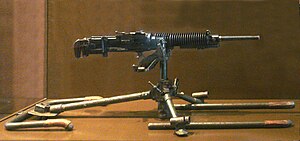The Type 3 heavy machine gun (三年式重機関銃, San-nen-shiki juu-kikanjuu), also known as the Taishō 14 machine gun,[1] was a Japanese air-cooled heavy machine gun. The Type 3 heavy machine gun was in a long-line of Japanese Hotchkiss machine gun variants that the Imperial Japanese Army would utilize from 1901 to 1945.[2]
| Type 3 machine gun | |
|---|---|
 Type 3 (Taishō 14) heavy machine gun. Musée de l'Armée, Paris | |
| Type | Heavy machine gun |
| Place of origin | Empire of Japan |
| Service history | |
| In service | 1914–1945 |
| Used by | See Users |
| Wars | World War I Warlord Era Second Sino-Japanese War Soviet–Japanese border conflicts World War II First Indochina War Korean War Vietnam War |
| Production history | |
| Designer | Kijiro Nambu |
| Designed | 1914 |
| Produced | 1914–1932 |
| Variants | Modelo 1920 |
| Specifications | |
| Mass | 55 kg (121 lb 4 oz) |
| Length | 119.8 cm (3 ft 11.2 in) |
| Barrel length | 737 mm (2 ft 5 in) |
| Cartridge | 6.5x50mm Arisaka 7×57mm Mauser |
| Rate of fire | 400-450 rounds per minute |
| Muzzle velocity | 740 m/s (2,400 ft/s) |
| Maximum firing range | 4 km (2.5 mi) |
| Feed system | 30 round Hotchkiss-style feed strip |
History edit
Starting in 1901, Japan began importing Hotchkiss MLE 1897 heavy machine guns that were compatible with belt fed 6.5mm Arisaka cartridges. Japan eventually bought a license for domestic production, with the type seeing notable service during the Russo-Japanese War [3]
Japanese gun designer Kijirō Nambu would later modify the domestic Hotchkiss MLE 1897 heavy machine gun to better meet Japanese requirements, to include lessons learned following the conclusion of the Russo-Japanese War. This effort would result in the adoption of the domestic Type 38 heavy machine gun in 1907. The Type 38 heavy machine gun would first see action in Qingdao, China during World War I. The Type 38 heavy machine gun was still in service at the time of the 1937 Marco Polo Bridge Incident.[4]
Kijirō Nambu would further modify the Type 38 heavy machine gun in 1909, focusing on improving dissipation and durability. This would result in the Type 3 heavy machine gun, entering service in 1914 and first seeing action in the 1919 Japanese intervention in Siberia. During the 1930s the Type 3 heavy machine gun would see wide-scale use in Manchuria and China during the Second Sino-Japanese War. The Type 3 tripod could be used as an anti-aircraft mounting, and special anti-aircraft sights were provided.[5]
Users edit
- Chile: Chile bought several hundred Type 3 machine guns in 7×57mm Mauser as Modelo 1920. Barrels were manufactured in France by Hotchkiss but most of the weapon was made at the Kokura arsenal.[6]
- China: Purchased for Chang Tso-lin's Fengtian Army.[7] Later used by the Collaborationist Chinese Army[8]
- Empire of Japan[9]
- Manchukuo[10]
- North Korea: It was used by the Korean People's Army during the Korean War.[11]
- North Vietnam[12]
Gallery edit
-
A Type 3 and Type 92 next to each other at a Beijing museum, showing the similarity
-
A 7-mm export gun in a Chilean museum
-
Ditto
-
In service with the Manchukuo Imperial Army
See also edit
Notes edit
- ^ Illustrated Directory of 20th Century Guns David Miller p.478
- ^ "MG".
- ^ "MG".
- ^ "MG".
- ^ "MG".
- ^ Legendre, Jean-François (July 2009). "Feed Strips for Japanese MGs". Small Arms Review. Vol. 12, no. 10.
- ^ Chinese Warlord Armies 1911-30 by Philip Jowett, page 22.
- ^ Jowett 2004, p. 86.
- ^ "Type 3 Type 92 Heavy Machine Guns - Japan". 2010-10-27.
- ^ Jowett, Philip S. (2004). Rays of the rising sun : armed forces of Japan's Asian allies, 1931-45. Vol. 1, China & Manchukuo. Helion. p. 15. ISBN 9781906033781.
- ^ Kinard, Jeff (2010). "Machine guns". In Tucker, Spencer C.; Pierpaoli, Paul G. Jr. (eds.). The Encyclopedia of the Korean War: A Political, Social, and Military History. Vol. 1. A-L (2nd ed.). ABC-CLIO. p. 535. ISBN 978-1-85109-849-1. Archived from the original on 2018-11-16. Retrieved 2018-11-15.
- ^ "Vũ khí Việt Nam trong hai cuộc kháng chiến". www.quansuvn.net. Retrieved 2020-07-12.
Bibliography edit
- McNab, Chris (2004). Twentieth-century Small Arms. Grange Books. p. 186. ISBN 1-84013-381-3.
External links edit
- Japanese machineguns of WW2
- Catalog of Enemy Ordnance Archived 2011-04-01 at the Wayback Machine